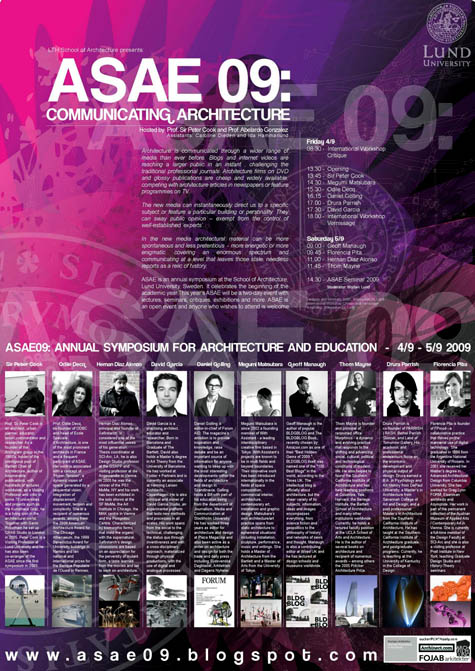Optioning Architecture
 This weekend in Lund, Sweden, Sir Peter Cook and Abelardo Gonzalez will be hosting the 2009 ASAE conference, the theme of which is Communicating Architecture.
This weekend in Lund, Sweden, Sir Peter Cook and Abelardo Gonzalez will be hosting the 2009 ASAE conference, the theme of which is Communicating Architecture.- ASAE is an annual symposium at the School of Architecture, Lund University, Sweden. It celebrates the beginning of the academic year. This year's ASAE will be a two-day event with lectures, seminar, critique, exhibition and more.
Unfortunately, I'll be speaking first thing Saturday morning! But I'll be giving a talk called "Optioning Architecture." There will be at least two major themes to be developed:
- 1) What are the options available to architects when it comes to communicating spatial ideas? Are renderings, plans, and diagrams still the most communicationally effective media to use (from the perspective of the interested public) or simply the most industrially useful (from the perspective of fellow architects and contractors)? What happens when, say, Bernard Tschumi's next building is not announced to the public via well-rendered images and a press release but in the form of a novel? There is also much to discuss here by inverting this scenario and asking: what happens when novelists, screenwriters, poets, and so on begin creating buildings to communicate their literary and narrative ideas, instead of producing texts? While this obviously risks repeating the textualist arguments of an earlier decade, it still seems worth asking what might have happened if James Joyce, for instance, had been a junior architect at KieranTimberlake: what effect might his literary urges have had upon that firm's built output? Put another, slightly cheesy, way: if Mervyn Peake had been a successful architect, what strange and sprawling manor houses might now exist somewhere in the English countryside? In any case, what, in the end, are the communicational options available to architects?

- 2) What possibilities exist for "optioning architecture," in the sense that a book, short story, or screenplay can be "optioned" by Hollywood for production in another media? That is, what might happen to the world of architectural design if your final graduate thesis project was to be optioned by Steven Spielberg or David Fincher? Would this be similar, in some ways, to the relationship between Rem Koolhaas's co-authored graduate thesis project, "Exodus, or the Voluntary Prisoners of Architecture," and Rupert Thomson's under-appreciated novel Divided Kingdom? To what extent is the latter a novelization of the former? Finally, would it be possible for someone from DreamWorks to come along, see a new museum under construction in Chicago or Baltimore, and then option it, the way he or she might option a promising novel? Could you literally translate the spatial dynamism and implied narrative logics of a building – could you option them – into an act of mainstream cinema? How might such a process work – and is there a reason why this hasn't yet occurred (i.e. it would be a totally ridiculous thing to do)?
The complete conference line-up includes Florencia Pita, David Garcia, Drura Parrish, Megumi Matsubara, and Daniel Golling. Read more on the conference blog.





Comments are moderated.
If it's not spam, it will appear here shortly!
don't forget "(writing/talking about music is like dancing about architecture" I've heard some have tried.
nice
I was really really inspired by your talk and kind of discovered that architecture could interest and intrigue me. those two days was like discovering your own kind of music when all you've heard so far had been music on the radio. //karin
Post a Comment